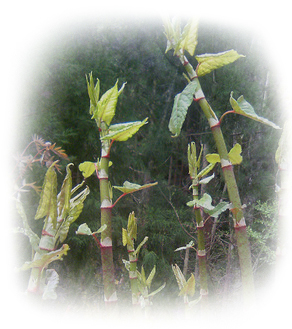Japanese Knotweed, Fleece Flower, Canadian Bamboo, Renouée du Japon • Legend and Lore • In the Garden |
|
Polygonum cuspidatum
Polygonaceae
Legend and Lore It is one of the first plants to appear in the springtime; a highly pervasive and invasive member of the buckwheat family. Polygonum – refers to the many jointed stem or swollen stem nodes, Cuspidatum –from the Latin cusp referring to the leaf’s sharp pointed tip. In Asia during World War II the leaves were dried and used as a substitute for tobacco. The Iroquois used it to rub down their horses to keep the flies away; the Elizabethan thought that by eating the knotweed it would stunt their growth! An extract made from knotweed and oak bark was used as substitute to Quinine (anti-malaria), knotweed has also been reported in some cancer treatment. Considered a rhubarb substitute it should be harvested when smaller than 30cm in height in the spring; then it morphs into a solid bamboo thicket too though to eat! In the Garden Disturbed wasteland, roadsides; forms large colonies of upright stems 75cm to 3m, smooth, mottled reddish-purple and often branching, hollow except at the nodes; reproducing by aggressive underground rhizomes - perennial bully. Leaves alternate, simple, 10 to 16cm in length, 10-16cm wide, broadly ovate, wavy margin. Flowers are small individual but numerous, forming a greenish white panicle from the axils of the upper leaves from July to September and rarely producing seeds. |
|


